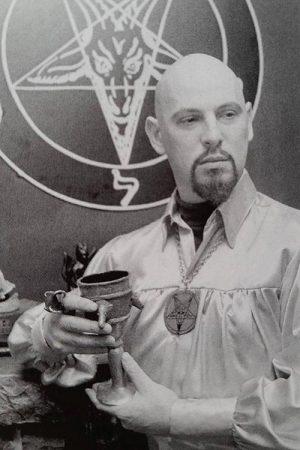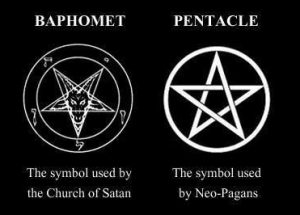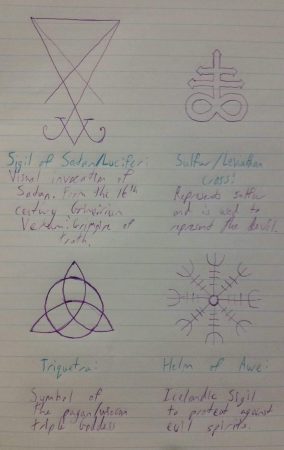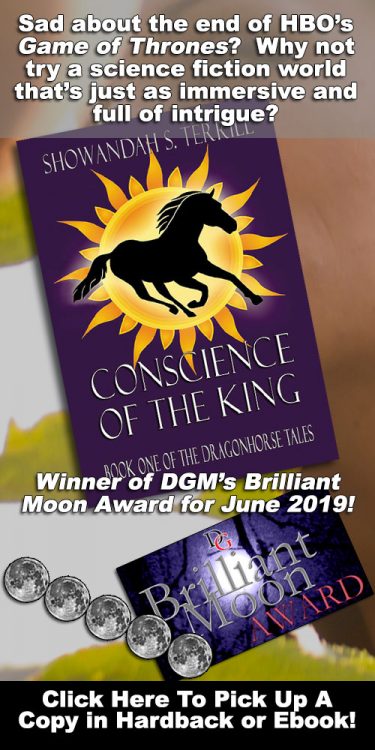Too many times I have observed either online or in person Goth fashion labelled as satanic and members of the Goth community labelled as devil worshippers or Satanists. Whilst some members in the Gothic community may be Satanists, this is not true of all Goths and is an unnecessary stereotype.
The question is: how did this association between Goth and Satanism come about? I will address this question by initially looking to the symbols and clothing worn by Goths. Secondly I will consider how the media began the association between Goth and Satanism. Finally I will investigate how events in history have shaped this association.
Origins of LaVeyan and Theistic Satanism
LaVeyan Satanism became an official religion with the beginning of the Church of Satan in 1966 by Anton Szandor LaVey.
The main idea of LaVeyan Satanism is that Satan is not a person but an amalgamation of mortal desires and acts. Satanism teaches that a person’s own interests should be their main priority so long as that does not cause harm to others.
Theistic Satanism, on the other hand, has no exact creation date, but is thought to be a religion that comes from many different groups of Satan worshippers coming together to form a larger group.
Theistic Satanism opposes LaVeyan Satanism in the fact that Theistic Satanists believe in the devil as an actual being and they worship him as such at Black Mass. Theistic Satanism uses more rituals than LaVeyan Satanism and is considered an older form of Satanism.
Despite the murky origins of Theistic Satanism, both variations of Satanism are considered to have developed in the 20th century, with older uses of the word “satanic” or “satanist” being used as an accusation against those thought to be committing evil acts, and who were believed to be in league with Satan. An example of this would be the Salem witch trials where the people tried were considered to be followers of Satan.
Symbols & Imagery
One of the first things that comes to mind when thinking of Satanism is of course the inverted pentagram of Baphomet. This is the official symbol of LaVeyan Satanism. Because this symbol is similar to the pagan pentacle used often in the Gothic community it is easy to see why some people would confuse the two symbols and believe that the wearer of the pentacle was actually wearing a satanic symbol.
Imagery used in the Goth community such as the Wiccan pentacle, voodoo symbols, and runic and Icelandic sigils, are easily confused with Satanic imagery if the person is not educated on the difference between the symbols. Satanism also uses Christian imagery, however this imagery is usually in opposite direction of what Christians would wear or display it as, such as the inverted cross.
The inverted cross originally used by the Christian Church as the cross of St Peter, is one of the earliest symbols of the Church of Satan and was used as a direct show of the churches opposition to Christianity and its beliefs. Inverted crosses are also a symbol sometimes used in the Gothic community, however much more common is the use of the ‘regular’ non-inverted cross.
This cross is often used in Victorian and medieval Gothic clothing and jewellery, more for aesthetics than religion. Because of the use of crosses, both traditional and inverted in both Goth and Satanism it is easy to confuse or associate a Gothic person with a Satanist.
When Christianity portrays the idea of God, he is portrayed as a shining light. As Satan is considered to be the opposite of God, then he would be portrayed in darkness. Dressing in all black, or dark colours with dark coloured hair could be seen as going towards the dark, or trying to associate themselves with darkness, evil and Satan. While wearing black, having hair dyed black or a colour that is not natural and wearing symbol jewellery, may be seen as something strange or even demonic as it strays from the type of dress that many think of as normal today.
One theory is that people see the Gothic culture as scary; by the way Goths dress and are afraid of Goths, thinking that the black clothes, makeup and symbols are all evil or satanic, mainly because they do not understand the culture. Many different styles of Goth use different imagery, Victorian uses crosses, Batcave uses ankhs, Cyber Goth uses biohazard symbols and tribal uses runic symbols. One style of Goth that uses more symbols than most is the newer style of Nu-Goth. Nu-Goth is characterised by black clothing with black, white or grey symbols imprinted into the clothing, coloured hair and symbol jewellery, placing importance on the symbols and patterns shown on the clothing. Take for example the Gothic clothing giant Killstar, their clothing is mainly in the Nu-Goth style, with clothing exhibiting voodoo symbols, the pentagram of Baphomet, Egyptian symbols and occult symbols adorning the outfits. The idea behind the use of all these different symbols, each originating from different places and religions is not to associate the wearer with a religion, but to understand the history behind the symbols and the power behind them.
The Gothic subculture is categorized not only by the clothing and aesthetic of the person, but also by the literature, music, art and lifestyle of the person. While some Satanists dress only in black and may appear Goth, they follow a different lifestyle altogether. Yes some Goths are Satanists, many are not, in the same way that some Goths are Christians, or Buddhists, or Wiccans/Pagans. Goth is not a religion therefore the people who identify as Goth are free to follow whichever religion they choose, or not follow any at all.
During the 1980’s a panic set in, called the Satanic Panic, focusing on the actions undertaken at so called Black Masses, stories of child abuse, torture, ritualistic sacrifice and cannibalism became the source of much panic over the increasing popularity of Satanism. It was thought that a Devil-worshipping cult had begun to commit horrible crimes. The media portrayed these individuals first as witches, and then later began calling them Satanists. The media also began to use the term Gothic to describe the Satanists lifestyles and clothing choices, using such sentences as ‘with all their Gothic finery.’ This created a link between the idea of a fundamentalist murderous Devil-worshiping cult and the Gothic community and due to the panic over anything to do with Satanism, Goths came into the line of fire, creating a damaging perception of the Gothic culture all perpetuated by the media.
One of the most controversial and influential figures of the Satanic Panic was Mike Warnke, the supposed leader of a Satanic coven who left Satanism to write a ‘tell all’ book called ‘The Satanic Seller’ It was this book that contributed largely to the growing panic over Satanism, leading to the beginning of the Satanic Panic. Warnke wrote of rituals and abuses committed by the church and the way in which members would dress, in all black with long hair, black makeup and black painted nails, an association with a Gothic dress sense. Warnkes book lead to many ‘witch hunts’, where people began to suspect teachers and carers of influencing children towards Satan or of committing ritualistic Satanic abuse, including human sacrifice. The book set the tone for a time of persecution and demonization of the Satanic religion and by association the Gothic culture. This was because Warnke told stories of how shows like Bewitched and rock music lead him to Satanism, demonising witchcraft, which was heavily associated with Goth. In 1992 an article by Cornerstone Magazine exposed Warnke as a fake, having never been a Satanist or been associated with the Church of Satan, Warnke was exposed as a Christian who aimed to harm the image of Satanism.

Clothing from the Gothic brand Killstar. The clothing features Pagan, Occult, Satanic and Celtic imagery, blending multiple images to create one overall style.
Media
However one of main reasons that the Gothic community has been so heavily associated with Satanism is due to the media incorrectly associating Goth culture with Satanism following the Columbine shootings. With the media already in a ‘Satanic Panic’ and associating Goth with Satanism they stated that the killers were Goth, while in reality the killers were not Goth, but incorporated Gothic symbolism into their group’s image. Articles such as ‘Gunmen Recalled as Outcasts’ by Marc Fisher for the Washington Post stated multiple times that the killers were Goth or Gothic, with quotes from students who said they thought that the killers worshiped the devil. The association between Goth and Satanism came about due to the media coverage of the tragic event. Because of this association the Gothic subculture became more feared and considered violent.
Also due to the media coverage of the fact that the shooters listened to Marilyn Manson – a Gothic singer and follower of LaVeyan Satanism, both Goth and Satanism became something for people to blame and fear. Marilyn Manson’s music usually involves themes of Satanism, with the teaser for his newest song centring around satanic imagery and a chorus focused on Satan, while many Goths listen to Marilyn Manson there is also a subgenre considered to be centred around Marilyn Manson, dressing like him and emulating this makeup, the people in this subgenre are usually referred to as Mansonites.
The media has thus played a large part in the assumption that all Goths or most Goths are Satanists or Satanic, with many stories portraying murders or other horrible acts undertaken by these Gothic Satanists. However the media forgets to mention that the horrible acts are undertaken by people who follow an idea of fundamentalist twisted Satanism, usually with the belief that Satan told them to commit the acts.
History

Baphomet – a deity associated with Satanism and thought to be worshipped by the Knights Templar, also used in Paganism as a symbol of the universe ie ‘man and woman, light and dark, good and evil.’
Whilst the media has a huge influence on the way that people view Gothic culture and Satanism, history shows that people have been labelled as Satanists for hundreds of years, usually for looking or being different. Think the Salem witch trials, because of the actions of certain town’s people a massive witch hunt began not only in America, but also in Europe. No one was safe, especially not if you were a woman, single and had a cat. These people were thought to be witches, people who followed the will of Satan. From this you can see that early on people who were different were targeted as being believers of Satan.
Witch symbolism is very present in the Gothic subculture today. It is possible that due to the association once held that all witches were Satan worshippers; people today still view witches, Wicca and Paganism as Satanic religions and practices. Again this association stems from a fear of something that is different. In history witches were seen as not only being Satan worshippers, but also practicing evil rites where they would perform murders, curses and cannibalism. This created a fear of people who identified as witches or wore witch symbols, as many people in the Gothic subculture do. During the middle ages anyone identifying as Pagan was thought to be a follower of Satan and persecuted as such.
One example of a witch ritual or tradition that has been heavily used in literature is Walpurgisnacht, or Witches Night. It was said that witches would gather on a mountain top and worship Satan. This features in the Gothic writing ‘The Dreams in the Witches House’ by H.P. Lovecraft, stating that ‘Hell’s blackest evil would roam the earth and the slaves of Satan would gather for nameless rites and deeds.’ Walpurgisnacht has also been mentioned in works by Bram Stoker and Goethe, while also being the subject of many songs, including ones by Black Sabbath and Fangoria. Because witch symbolism is so present in Gothic culture looking back at how witches were portrayed as Satan worshippers gives a better understanding of why people would still think that today.
Other groups in history were alleged to be followers of Satan, such as the Knights Templar and the Protestants after their break away from the Catholic Church. This accusation usually happened because the interests of one group did not follow the interests of the Church, therefore they were thought to be in league with Satan.
Satanism is a complex religion that has often been misunderstood by the media and due to the media association between Goth and Satanism the panic and fear that many felt towards Satanism has extended to include the Goth subculture. People look at Goths and incorrectly assume that we are all Satanists, whilst some of us may be, many follow other religions, or follow none at all. The only way to change this idea that all Goths are Satanists is to educate people on the difference between the two.
Conclusion
So I will leave you with this question: have you ever been accused of being a Satanist just because you are Goth? If so why do you think that happened …. is it history, symbolism or sheer fear of the unknown that makes people feel the need to label Goths as Satanists, or is it just a lack of understanding on their part?





October 29, 2019
Killstar and gothic really?
August 28, 2021
I am Romantic Goth and trans gender and so I have been condemned as homosexual child predator, occult obsessed, etc. Funny thing none of it is true. Sad how people get to be brain washed, especially by toxic theology.